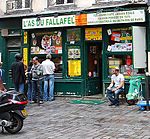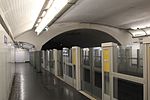Pletzl

The Pletzl (פלעצל, "little place" in Yiddish) is the Jewish quarter in the 4th arrondissement of Paris, France. The Place Saint-Paul and the surrounding area were unofficially named the Pletzl when the neighborhood became predominantly Jewish after an influx of immigrants in the late 19th and early 20th centuries. The area hosts a diverse Jewish community, assembling traditional Jewish families as well as many more who arrived through immigration from Eastern Europe and North Africa through the past centuries. The area is now characterised by its synagogues, butchers, delicatessens, and falafel vendors, which provide a social and cultural fabric for its inhabitants. The darkest days for the Pletzl came during World War II, when Vichy France's collaboration with the Nazis resulted in raids that saw many residents abducted and sent off to concentration camps. Today, the community is an extremely religious Orthodox one, and most citizens belong to one of the three local synagogues: one located at 17 Rue des Rosiers, another at 25 Rue des Rosiers, and the last one at 10 Rue Pavée; the latter is an art nouveau temple designed by Hector Guimard, famous for his work on the Paris Métro.
Excerpt from the Wikipedia article Pletzl (License: CC BY-SA 3.0, Authors, Images).Pletzl
Rue des Rosiers, Paris 4th Arrondissement (Paris)
Geographical coordinates (GPS) Address Nearby Places Show on map
Geographical coordinates (GPS)
| Latitude | Longitude |
|---|---|
| N 48.857011111111 ° | E 2.3596638888889 ° |
Address
Rue des Rosiers 9
75004 Paris, 4th Arrondissement (Paris)
Ile-de-France, France
Open on Google Maps











